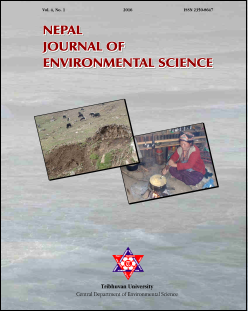Energy consumption pattern and renewable energy alternatives in Madi Kalyanpur, Chitwan, Nepal
DOI:
https://doi.org/10.3126/njes.v4i0.22724Keywords:
Cost-benefit Ratio, Cost Payback Period, Greenhouse gasses emission, Solar House SystemAbstract
Energy consumption pattern and greenhouse gases emission are interrelated. The unsustainable use of biomass and widespread use of commercial energy are of the major sources of greenhouse gas emission. The alternative to kerosene for lighting is solar home system (SHS), which is one of the potential renewable technologies for rural electrification. The present study has analyzed household energy consumption pattern and greenhouse gases emission from energy consumption practices as well as environmental and economic benefits of SHS in Madi Kalyanpur Village Development Committee of Chitwan district. For the purpose, the primary data were collected through household questionnaire survey, key informant interview (KII) and focus group discussion (FGD). The analysis has shown that 22% of household use all types of energy, i.e. fuel-wood, LPG (liquefied petroleum gas), biogas and SHS as the sources of energy. Thirty-five percent households use fuel-wood, LPG and SHS, 24% use fuel-wood, biogas and SHS, 1% used LPG and SHS, 5% use biogas and SHS, 4% use LPG, biogas and SHS and 9% use fuel-wood and SHS as a source of energy. Almost all people have been using SHS for the lighting purpose. The average annual greenhouse gases emission per household from fuel-wood and liquefied petroleum gas consumption was 7.89 ton and 0.17 ton of CO2 equivalent respectively. Typically, a 40 Wp SHS reduced the consumption of kerosene by 42 liter annually for lighting that displaced 0.11 ton of CO2 equivalent per household per year. The simple payback period for typically 40 Wp SHS was found to be nine years with no subsidy, seven years with subsidy from Alternative Energy Promotion Centre and two years with Indian Government Grant. Similarly, the benefit-cost ratios were found to be 3.1, 3.5 and 4.6 for the systems with no subsidy, with AEPC subsidy and with Indian Grant, respectively.
Downloads
Downloads
Published
How to Cite
Issue
Section
License
This license enables reusers to distribute, remix, adapt, and build upon the material in any medium or format for noncommercial purposes only, and only so long as attribution is given to the creator.




